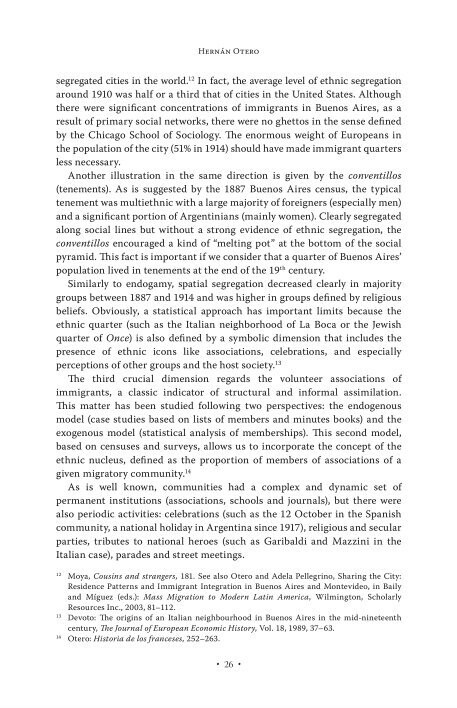

OCR
HERNÁN OTERO segregated cities in the world.” In fact, the average level of ethnic segregation around 1910 was half or a third that of cities in the United States. Although there were significant concentrations of immigrants in Buenos Aires, as a result of primary social networks, there were no ghettos in the sense defined by the Chicago School of Sociology. The enormous weight of Europeans in the population of the city (51% in 1914) should have made immigrant quarters less necessary. Another illustration in the same direction is given by the conventillos (tenements). As is suggested by the 1887 Buenos Aires census, the typical tenement was multiethnic with a large majority of foreigners (especially men) and a significant portion of Argentinians (mainly women). Clearly segregated along social lines but without a strong evidence of ethnic segregation, the conventillos encouraged a kind of “melting pot” at the bottom of the social pyramid. This fact is important if we consider that a quarter of Buenos Aires’ population lived in tenements at the end of the 19 century. Similarly to endogamy, spatial segregation decreased clearly in majority groups between 1887 and 1914 and was higher in groups defined by religious beliefs. Obviously, a statistical approach has important limits because the ethnic quarter (such as the Italian neighborhood of La Boca or the Jewish quarter of Once) is also defined by a symbolic dimension that includes the presence of ethnic icons like associations, celebrations, and especially perceptions of other groups and the host society.” The third crucial dimension regards the volunteer associations of immigrants, a classic indicator of structural and informal assimilation. This matter has been studied following two perspectives: the endogenous model (case studies based on lists of members and minutes books) and the exogenous model (statistical analysis of memberships). This second model, based on censuses and surveys, allows us to incorporate the concept of the ethnic nucleus, defined as the proportion of members of associations of a given migratory community.“ As is well known, communities had a complex and dynamic set of permanent institutions (associations, schools and journals), but there were also periodic activities: celebrations (such as the 12 October in the Spanish community, a national holiday in Argentina since 1917), religious and secular parties, tributes to national heroes (such as Garibaldi and Mazzini in the Italian case), parades and street meetings. 2 Moya, Cousins and strangers, 181. See also Otero and Adela Pellegrino, Sharing the City: Residence Patterns and Immigrant Integration in Buenos Aires and Montevideo, in Baily and Miguez (eds.): Mass Migration to Modern Latin America, Wilmington, Scholarly Resources Inc., 2003, 81-112. Devoto: The origins of an Italian neighbourhood in Buenos Aires in the mid-nineteenth century, The Journal of European Economic History, Vol. 18, 1989, 37-63. 4° Otero: Historia de los franceses, 252-263. + 26 +
Structural
Custom
Image Metadata
- Image width
- 1830 px
- Image height
- 2834 px
- Image resolution
- 300 px/inch
- Original File Size
- 1.22 MB
- Permalink to jpg
- 022_000037/0026.jpg
- Permalink to ocr
- 022_000037/0026.ocr
